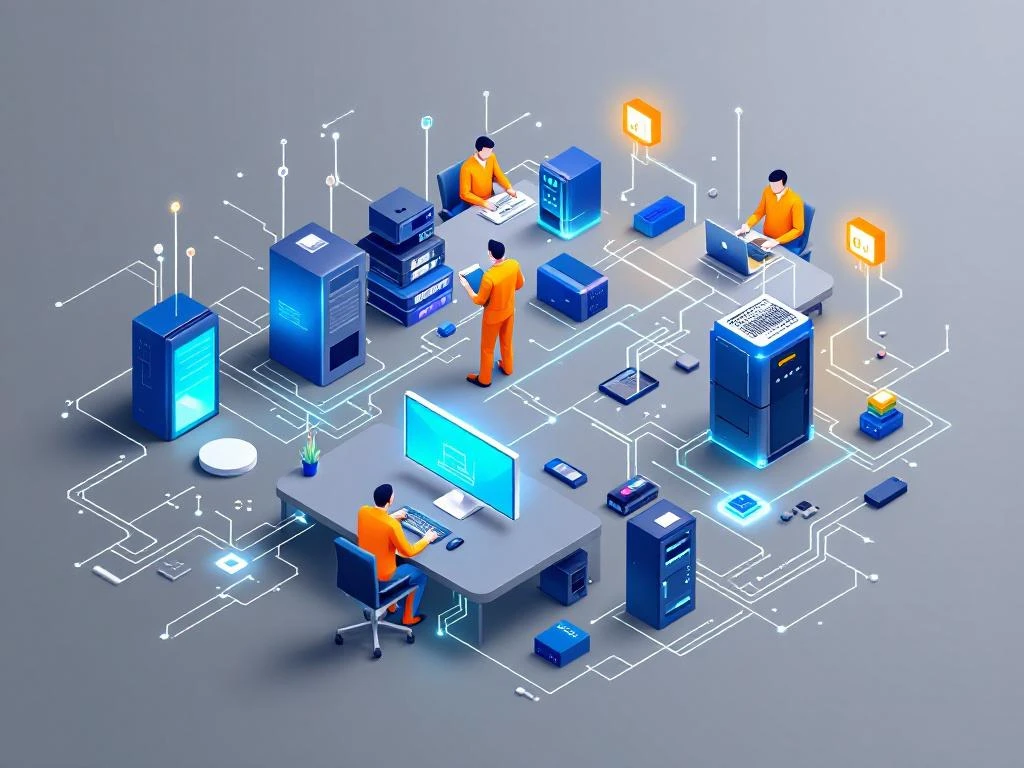
When your business relies on complex IT infrastructure across multiple locations, having skilled technicians physically present to solve problems becomes more than just convenient, it’s often the only way to keep operations running smoothly. Onsite IT support means having qualified professionals come directly to your location to handle technical issues that can’t be resolved remotely. Whether you’re dealing with hardware failures, network installations, or urgent system repairs, onsite support bridges the gap between what remote assistance can achieve and what your business actually needs to maintain productivity.
How does onsite IT support work for businesses?
The process of getting onsite technical support starts when you identify an issue that requires hands-on attention. Unlike remote support where technicians access your systems through the internet, onsite support involves dispatching qualified field technicians to your physical location. This typically begins with an initial assessment call where support teams determine whether the problem genuinely needs on-location assistance or if remote troubleshooting might suffice.
Once the need for onsite presence is established, the dispatch process kicks into gear. Professional IT service providers maintain networks of technicians across different regions, allowing them to match the right expert with your specific needs and location. Response times vary based on service level agreements (SLAs), but most providers offer options ranging from same-day emergency response to scheduled next-business-day visits for less critical issues.
The distinction between remote and onsite support becomes clear when you consider the types of problems each can address. Remote support works brilliantly for software configuration, user training, and system diagnostics. However, when you’re facing hardware failures, physical network installations, or issues requiring direct access to servers and equipment, only onsite support will do. Think of it this way: if the problem involves touching, moving, or replacing physical components, you need someone there in person.
Common onsite IT support services you need
Hardware installation and replacement forms the backbone of most onsite technical support requests. When a server fails at your data centre or a critical workstation stops functioning, technicians arrive equipped to diagnose the problem, source replacement parts, and get systems operational again. This might involve swapping out failed hard drives, installing new memory modules, or completely replacing malfunctioning equipment.
Network device configuration represents another crucial service area. Setting up routers, switches, and wireless access points requires not just technical knowledge but physical presence to run cables, mount equipment, and test connections. For instance, when expanding office space or opening new locations, technicians handle everything from initial site surveys to final connectivity testing, ensuring your network infrastructure meets both current needs and future growth plans.
Deskside support addresses the daily technical challenges your employees face. Rather than forcing staff to troubleshoot complex issues themselves or wait for IT to walk them through solutions over the phone, onsite technicians provide immediate, hands-on assistance. This includes everything from resolving printer problems and setting up new workstations to recovering lost data and fixing software conflicts that disrupt productivity.
Data centre services demand specialised expertise, particularly for rack-and-stack operations. When you’re deploying new servers or reorganising existing infrastructure, technicians manage the physical installation, cable management, and initial configuration. They ensure proper ventilation, power distribution, and adherence to data centre best practices that remote support simply cannot verify.
Emergency break-fix support represents perhaps the most critical service category. When systems fail outside normal business hours or during peak operational periods, having access to technicians who can respond immediately prevents minor issues from becoming major disasters. Whether it’s a failed backup system discovered during overnight processing or a network outage affecting point-of-sale systems during busy retail hours, rapid onsite response minimises downtime and revenue loss.
Benefits of professional onsite IT support
The most immediate benefit of professional onsite support is dramatically reduced downtime. When critical systems fail, every minute counts. Having technicians who can arrive quickly and resolve issues on-site eliminates the back-and-forth troubleshooting that often extends remote support sessions. This direct approach means problems get fixed faster, and your operations return to normal sooner.
Maintaining consistent service quality across multiple locations presents a significant challenge for businesses operating regionally or globally. Professional IT field services solve this by providing standardised support regardless of geography. Whether you need assistance at headquarters or a remote branch office, you receive the same level of expertise and service quality, ensuring no location becomes a weak link in your IT infrastructure.
Compliance and security protocols become increasingly important as businesses face stricter regulations and heightened cyber threats. Professional onsite support providers ensure their technicians follow proper safety procedures, maintain security clearances, and understand industry-specific compliance requirements. This means you’re not just getting technical expertise but also peace of mind that work is performed according to established standards and regulations.
Cost considerations often surprise businesses when they compare maintaining internal field teams versus outsourcing onsite support. Keeping qualified technicians on staff for every location proves expensive, especially when you factor in training, benefits, and idle time between incidents. Professional support services provide access to skilled technicians exactly when needed, converting fixed labour costs into variable operational expenses that scale with actual requirements.
Geographic coverage challenges dissolve when you partner with providers maintaining extensive technician networks. Instead of struggling to find qualified support in remote locations or dealing with extended response times, you gain access to local expertise wherever your operations extend. This proves particularly valuable for businesses expanding into new markets or managing facilities across diverse regions.
What makes reliable onsite IT support different?
The distinction between reliable and mediocre onsite support often comes down to the quality of technicians deployed. Employee-based models, where technicians work directly for the service provider rather than as subcontractors, ensure consistent training, accountability, and service delivery. These technicians represent their company’s reputation with every service call, motivating them to maintain high standards and build lasting client relationships.
Round-the-clock availability separates professional providers from basic support services. IT infrastructure support needs don’t follow business hours, and neither should your support options. True 24/7 availability means having technicians ready to respond at 3 AM on Sunday just as readily as during regular weekday hours, ensuring critical systems receive attention whenever problems arise.
Language capabilities and cultural understanding matter more than many businesses initially realise. Multilingual technicians who can communicate effectively with your staff reduce misunderstandings and accelerate problem resolution. This becomes especially important in diverse work environments or when supporting international operations where English might not be the primary language.
Safety training and security protocols distinguish professional technicians from casual IT help. Proper certifications ensure technicians understand workplace safety requirements, particularly important in industrial settings or data centres with specific access procedures. Background checks and security clearances provide additional assurance when technicians need access to sensitive areas or confidential information.
Standardised service delivery processes ensure consistent results regardless of which technician responds to your call. This includes proper documentation of work performed, adherence to change management procedures, and clear communication throughout the service process. When every technician follows the same proven methodologies, you experience predictable, reliable outcomes rather than varying results based on individual approaches.
How IMPLI-CIT delivers onsite IT support across Europe
Our approach to onsite support centres on maintaining a network of employed technicians rather than relying on subcontractors. This means when you request support, you’re getting professionals we’ve trained, certified, and integrated into our service culture. Each technician undergoes comprehensive background checks and maintains VCA-VOL safety certification, ensuring they meet the highest standards for both technical competence and workplace safety.
We’ve built our service model around the real needs of businesses managing multi-site IT management challenges. Our technicians handle everything from routine hardware deployment to emergency repairs, providing the consistent quality your operations demand. Whether you need someone to perform rack-and-stack operations in a data centre or troubleshoot user issues at remote offices, our team arrives prepared with the right skills and tools.
Our global coverage extends well beyond Europe, reaching into Asia, Africa, and the Americas. This extensive network means we can support your operations wherever they expand, maintaining the same service standards and response capabilities across all locations. Combined with our 24/7 availability and multilingual capabilities, we ensure language barriers and time zones never compromise your IT support needs.
To learn more about our comprehensive service offerings and how we can support your specific IT infrastructure needs, explore our services page. You can also discover the different types of skilled professionals in our network by visiting our onsite technicians overview.
How quickly can I expect an onsite technician to arrive for emergency support?
What should I prepare before an onsite technician arrives?
How do I determine if I need onsite support versus remote assistance?
What are the typical costs for onsite IT support services?
Can onsite technicians work on equipment still under manufacturer warranty?
How do I ensure security when allowing external technicians access to our facilities?
What is Onsite IT Support?
